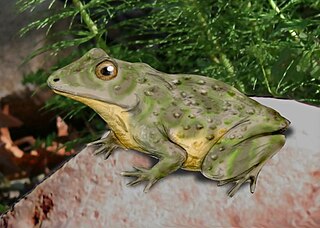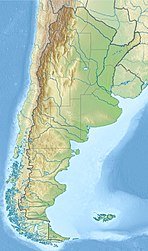
The Paleoproterozoic Era, spanning the time period from 2,500 to 1,600 million years ago (2.5–1.6 Ga), is the first of the three sub-divisions (eras) of the Proterozoic Eon. The Paleoproterozoic is also the longest era of the Earth's geological history. It was during this era that the continents first stabilized.
Hydrothermal circulation in its most general sense is the circulation of hot water. Hydrothermal circulation occurs most often in the vicinity of sources of heat within the Earth's crust. In general, this occurs near volcanic activity, but can occur in the shallow to mid crust along deeply penetrating fault irregularities or in the deep crust related to the intrusion of granite, or as the result of orogeny or metamorphism. Hydrothermal circulation often results in hydrothermal mineral deposits.

Eclogite is a metamorphic rock containing garnet (almandine-pyrope) hosted in a matrix of sodium-rich pyroxene (omphacite). Accessory minerals include kyanite, rutile, quartz, lawsonite, coesite, amphibole, phengite, paragonite, zoisite, dolomite, corundum and, rarely, diamond. The chemistry of primary and accessory minerals is used to classify three types of eclogite. The broad range of eclogitic compositions has led a longstanding debate on the origin of eclogite xenoliths as subducted, altered oceanic crust.

Mount Hudson is a stratovolcano in southern Chile, and the site of one of the largest eruptions in the twentieth century. The mountain itself is covered by a glacier. There is a caldera at the summit from an ancient eruption; modern volcanic activity comes from inside the caldera. Mount Hudson is named after Francisco Hudson, a 19th-century Chilean Navy hydrographer.

The geology of the Falkland Islands is described in several publications. The Falkland Islands are located on a projection of the Patagonian continental shelf. In ancient geological time this shelf was part of Gondwana, which around 400 million years ago broke from what is now Africa and drifted westwards relative to Africa. Studies of the seabed surrounding the islands indicated the possibility of oil. Intensive exploration began in 1996, although there had been some earlier seismic surveys in the region.

Vieraella is an extinct genus of frog from the Lower Jurassic Roca Blanca Formation of Argentina, and one of the oldest true frogs known. This genus is known by a single excepcionally well preserved specimen, P.V.L. 2188, with at least eight presacrals vertebrae, free ribs, ulna and radius not fused, bony skull with some discoglossid characters.
Mentolat is an ice-filled, 6 km (4 mi) wide caldera in the central portion of Magdalena Island, Aisén Province, Chilean Patagonia. This caldera sits on top of a stratovolcano which has generated lava flows and pyroclastic flows. The caldera is filled with a glacier.

Notobatrachus is an extinct genus of frog from the Lower Jurassic (Toarcian) Cañadon Asfalto Formation, Cañadón Asfalto Basin and Middle Jurassic La Matilde Formation, Deseado Massif of Patagonia, Argentina. N. degiustoi is the most completely known Jurassic frog and has been recorded in many outcrops of the La Matilde Formation of the Deseado Massif in southern Patagonia.

The Cañadón Asfalto Formation is a geological formation from the Lower to Middle Jurassic. The Cañadón Asfalto Formation is located in the Cañadón Asfalto Basin, a rift basin in the Chubut Province of northwestern Patagonia, southern Argentina. The basin started forming in the earliest Jurassic.
The Cerro Vanguardia Mine is a gold and silver mine located 150 km north west of Puerto San Julián, in the Santa Cruz province of Argentina. It is majority-owned and operated by AngloGold Ashanti, which holds a 92.5% interest in the mine. The remaining 7.5% are owned by Formicruz, a company owned by the province of Santa Cruz.
Equisetum thermale is an extinct horsetail species in the family Equisetaceae described from a group of whole plant fossils including rhizomes, stems, and leaves. The species is known from Middle to Late Jurassic sediments exposed in the province of Santa Cruz, Argentina. It is one of several extinct species placed in the living genus Equisetum.
The Manantial Espejo mine is a large silver mine located in Deseado Massif in Santa Cruz Province, southern Patagonia. Manantial Espejo represents one of the largest silver reserve in Argentina and in the world having estimated reserves of 25.7 million oz of silver.
Aguas Calientes is a major Miocene caldera in Salta Province, Argentina. It is in the Central Volcanic Zone of the Andes, a zone of volcanism covering southern Peru, Bolivia, northwest Argentina and northern Chile. This zone contains stratovolcanoes and calderas.
Cerro Bitiche is a volcanic field in Argentina. It is located east of the Central Volcanic Zone away from the volcanic arc within the Altiplano-Puna volcanic complex (APVC), close to Zapaleri volcano.
The Chon Aike Formation is an extensive geological formation, present in the Deseado Massif in north-central Santa Cruz Province, Patagonia, Argentina. It covers an area of approximately 100,000 square kilometres (39,000 sq mi) and consists of rhyolitic volcanic rocks, particularly ignimbrites and lavas, with smaller amounts of agglomerates and tuffs. Within dacitic rocks, plant fossils have been found.

Patagonia comprises the southernmost region of South America, portions of which lie on either side of the Argentina-Chile border. It has traditionally been described as the region south of the Rio Colorado, although the physiographic border has more recently been moved southward to the Huincul fault. The region's geologic border to the north is composed of the Rio de la Plata craton and several accreted terranes comprising the La Pampa province. The underlying basement rocks of the Patagonian region can be subdivided into two large massifs: the North Patagonian Massif and the Deseado Massif. These massifs are surrounded by sedimentary basins formed in the Mesozoic that underwent subsequent deformation during the Andean orogeny. Patagonia is known for its vast earthquakes and the damage they cause.

The Pali-Aike volcanic field is a volcanic field along the Argentina–Chile border. It is part of a family of back-arc volcanoes in Patagonia, which formed from processes involving the collision of the Chile Ridge with the Peru–Chile Trench. It lies farther east than the Austral Volcanic Zone, the volcanic arc that makes up the Andean Volcanic Belt at this latitude. Pali-Aike formed over sedimentary rock of Magallanes Basin, a Jurassic-age basin starting from the late Miocene as a consequence of regional tectonic events.
Cerro de los Chenques is a monogenetic volcano in the Chubut Province, Argentina, which was considered to be of Holocene age but was later re-dated to be of lower Pleistocene age. The volcano developed on a basement formed by Mesoproterozoic and Neoproterozoic rocks and more recent volcanic and granitic formations.

The Cañadón Calcáreo Formation is an Oxfordian to Kimmeridgian-aged geologic formation, from the Cañadón Asfalto Basin in Chubut Province, Argentina, a rift basin that started forming since the earliest Jurassic. It was formerly thought to date into the Cretaceous, but the age has been revised with Uranium–lead dating as likely being solely Late Jurassic in age.
The Anfiteatro de Ticó Formation is a geological formation from the Deseado Massif in the province of Santa Cruz, Argentina.









